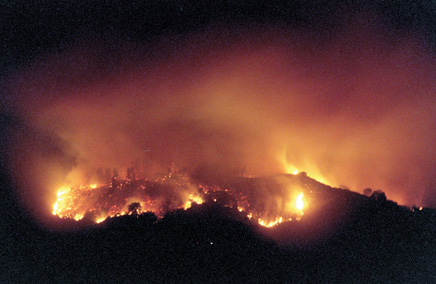
Several factors have come together to produce a high fire danger
in regional grasslands
As a brown haze blurred the Diablo Mountains from Morgan Hill to
Hollister this week from the so-called Canyon Fire, which at press
time consumed some 20,000 acres on the border of Santa Clara and
Stanislaus counties, it became a stark reminder that climatic
shifts to longer, hotter summers, combined with abundant fuel from
a verdant spring, is posing an enormous threat to South Valley and
San Benito County property.
Several factors have come together to produce a high fire danger in regional grasslands
As a brown haze blurred the Diablo Mountains from Morgan Hill to Hollister this week from the so-called Canyon Fire, which at press time consumed some 20,000 acres on the border of Santa Clara and Stanislaus counties, it became a stark reminder that climatic shifts to longer, hotter summers, combined with abundant fuel from a verdant spring, is posing an enormous threat to South Valley and San Benito County property.
Four years ago, the Croy Road fire swept through the South Valley foothills of the Santa Cruz Mountains, burning 3,100 acres and destroying 32 structures.
Firefighters who responded to the fire said that one of the first problems they faced as the battled the blaze was the clearance around the homes. Many of the homes were older and several had secondary structures on the premises.
“There were fire prevention measures people should have taken, securing 100-foot clearances around structures. It’s been a long road to hoe, but people are paying attention now. More people are in compliance and we’re making more inspections,” said Chris Morgan, Fire Prevention Specialist for the California Department of Forestry, Santa Clara Unit.
The Croy Road fire happened during a typical year, when brush is average length and density. This year has been an especially wet one, boosting the height and density of grasses. This makes it harder to extinguish, said San Benito County CDF Battalion Chief Jeff Row.
“Thicker and taller grass means brush that is harder to extinguish and longer flame lengths. Taller and thicker grass also stands a better chance of igniting,” Row said.
Adding to the dangers from the tinder-dry grasses, scientists say there are indications that summers are growing longer and hotter, therefore increasing potential risks of wildfires.
New research published in the journal Science and recently presented on the July 7 edition of National Public Radio, said that global warming may be causing more intense wildfires in the western United States. Researches found that large wildfire activity that has increased in the western states during the past 25 years is “strongly associated with increased spring and summer temperatures and an earlier spring snowmelt.”
The combination of these factors coming together this year – call it a perfect inferno – has local fire officials strongly advocating residents take matters into their own hands and practice prevention. The good news is that CDF and local fire officials say the majority of residents are doing their part. The San Benito CDF conducted 100 inspections of residences this year and 80 percent of homes inspected were in compliance with fire ordinances, Row said.
“Most folks are fairly knowledgeable and keep their homes nicely landscaped and are cognizant of vegetation fires. Other folks are completely lacking knowledge or just don’t care,” Row said.
Every year Santa Clara CDF inspects 2,400 structures and like San Benito County, the majority of homes are in compliance with fire safety laws that stipulate that homes must have a 100-foot clearing around their perimeter.
The initial 30 feet immediately surrounding the home requires the greatest reduction in flammable vegetation. The fuel reduction zone is the remaining 70 feet, or the property line.
Spacing between trees and plants improves the chances of slowing or stopping a wildfire before it destroys a home.
One major misconception people have is that large trees have to be cut down. It’s more important to remove all of the plants beneath them. This eliminates a vertical fire ladder – where the fire starts with grass, moves to brush and makes it way up a tree burning everything in its path; the fewer low branches means less fuel for the fire.
The problem with clearing some areas, especially those closer to undeveloped land, is the endeavor can be costly and, frankly, people can be lazy. Some areas allow controlled burns, while others do not, but even when burning is allowed, residents are limited as to what they can burn.
Herds of wild goats are being introduced as a means of controlling vegetation in some areas of San Benito County. Row said that there are even companies that rent out goats for the purpose of controlling brush. Row said that the goats are effective in cutting down the dangers of overgrowth.
One area in San Benito County especially vulnerable to wildfire threat is San Juan Canyon. Steep hills and one main road in and out of the canyon are two major problems. Houses are located up and down the canyon, which could easily burn if a fire rages out of control.
“With the way the wind moves through the canyon, if a fire got going, it wouldn’t take long for the whole thing to go up,” said Sandra Davidson, who lives in San Juan Canyon.
Fortunately, there is more than one emergency exit from the canyon; the problem is informing everyone of escape routes.
“People who move out here like to keep to themselves; that makes it hard to inform people about what’s going on,” said Cindy Reeves, administrative consultant with the San Benito Firesafe Council.
The Firesafe Council is a nonprofit coalition of public and private sector organizations that share a goal of reducing losses from wildfire.
The organization was established in 2001 to solve the problems related to wildfires: prevention of the loss of lives and structures, protection of the habitat and needs of wildlife, and preservation of the natural landscape.
Shortly after the organization was established they started a residential chipper program, funded through state and federal grants. Through the program, homeowners cut and remove brush and the Firesafe Council provides a crew and chipper to chip the brush. The project has widespread support throughout the community and is essential in reducing hazardous vegetation in neighborhoods in the county.
“The problem with clearing out the brush from your property is that when you do it yourself it’s often very costly, which is why a lot of people don’t want to do it,” Reeves said.
All residents have to do is put out their trimmings, preferably with the cut ends toward the roadside, and the chipper will come by and chip them, said Reeves. The homeowner can either haul them away, or if the resident wants they can keep the chippings for groundcover, the chipper will blow the chips onto their property.
Currently the chipping program is limited to the San Juan Canyon and Aromas areas, but the group would like to eventually extend the program so that it includes parts of Cienega and Southside roads.
The first chipping program this year was offered in June, but no residents signed up to participate. The next session is scheduled for July 17-21 and 60 people have signed up.
Guidelines for participation
· All vegetative material must be cut and piled curbside for pickup with cut branches facing the curb.
· Anything that cannot readily be chipped will not be picked up.
· No loose materials, including grass sod or firewood chunks and nothing larger than four inches in diameter can be chipped.
· To sign up for chipping contact Cindy Reeves 831-623-1677 at the San Benito Firesafe Council office.
How to keep homes fire-safe
The California Department of Forestry offers a number of tips for how to make your home fire safe.
Kitchen:
Keep a working fire extinguisher in the kitchen.
Keep baking soda on hand to extinguish stove-top grease fires.
Install curtains and towel holders away from burners on the stove.
Make sure that electrical outlets are designed to handle appliance loads.
In the living room:
Install a screen in front of the fireplace or wood stove.
Store the ashes from your fireplace (and barbecue) in a metal container and dispose of only when cold.
Around the house:
Install smoke detectors between living and sleeping areas.
Test smoke detectors monthly and replace batteries twice per year, when clocks are changed in the spring and fall.
Replace electric cords that do not work properly, have loose connections, or are frayed.
In the bedroom, if you sleep with the door closed, install a smoke detector in the bedroom.
Turn off electric blankets and other electrical appliances when not in use.
If you have security bars on your windows or doors, be sure they have an approved quick-release mechanism so you and your family can get out in the event of a fire.
Disconnect appliances such as curling irons and hair dryers when done; store in a safe location until cool.
Keep items such as towels away from wall and floor heaters.
Outside the Home
Identify at least two exit routes from your neighborhood.
Construct roads that allow two-way traffic.
Design road width, grade and curves to allow access for large emergency vehicles.
Construct driveways to allow emergency equipment to reach your house.
Remove branches within 10 feet of your chimney and dead branches overhanging your roof.
Remove dead leaves and needles from your roof and gutters.
Install a fire resistant roof. Contact your local fire department for current roofing requirements.
Cover your chimney outlet and stovepipe with a nonflammable screen of ½ inch or smaller mesh.
Create a “defensible space” by removing all flammable vegetation at least 30 feet from all structures. On slopes or in high fire hazard areas remove flammable vegetation out to 100 feet or more.
Landscape with fire resistant plants. For a list of fire resistant plants call your local fire department.
For trees taller than 18 feet, remove lower branches within six feet of the ground.
Contact your local fire department to see if open burning is allowed in your area; if so, obtain a burning permit.
All these and other helpful hints are available in handouts from the San Benito Firesafe Council and the California Department of Forestry. Visit their websites at www.sbfsc.org and www.fire.ca.gov respectively.
— Patrick O’Donnell









